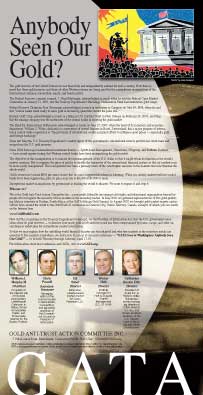You are here
South Africa: A rich country insisting on being poor
South Africa is a member of the International Monetary Fund, whose bylaws forbid members from linking their currencies to gold -- the metal on which South Africa was and still could be built, the metal whose price the IMF helps suppress.
* * *
South Africa's Miners Face Deepening Gloom
By Tom Burgis
Financial Times, London
Thursday, February 5, 2009
http://www.ft.com/cms/s/0/4ac8f142-f39f-11dd-9c4b-0000779fd2ac.html?ncli...
The ammonia still hangs heavy in the air from the last blast. Drenched in sweat, the faces of the miners on the morning shift betray nothing but concentration. Yet when the previous night's explosion took them a few metres further into the South African rock this week, their gold mine, Mponeng, became the world's deepest.
The pride of the managers at Anglogold Ashanti's flagship operation is not enough, however, to reverse the terminal decline of an industry that at its peak in the 1970s produced two-thirds of the world's gold.
Today, South Africa's mines account for less than 10 per cent of supply. Last year, output fell by 14 per cent to an estimated 232 tonnes, pushing the country into third place behind China and the US, according to GFMS, the consultancy.
The last time output fell so precipitously, in 1901, the Boer war was raging and bubonic plague was rife in Cape Town.
That Mponeng has surpassed its neighbour to reach a depth of 3,778 meters is a reminder that South Africa's mines are deep and difficult: 123 years after the stupendous riches of the Witwatersrand basin lured its first prospectors to a settlement they called Johannesburg, they could hardly be otherwise.
"We've gone through all the sweet spots," says Graham Briggs, chief executive of Harmony, the world's ninth biggest producer whose entire production currently comes from South Africa. "The grade [quality] year on year is downwards."
South Africa's woes spread well beyond its domestic miners into the global gold market, helping to hold down the world's mine gold supply last year to 2,385 tonnes, down 3.6 per cent from 2007. That drop, just as investors are hoarding gold amid the global financial crisis, has helped to push gold prices above $900 an ounce. The only reason prices are not higher is because jewellery demand for gold, particularly in India and the Middle East, has collapsed.
Banks such as UBS and Goldman Sachs this week have forecast that gold prices will rise above $1,000 an ounce in the near term, probably hitting an all-time high.
John Reade, a precious metal strategist at UBS in London, says fear is helping to drive up prices. "Purchases of physical gold have jumped over the past six months as investors' fears about the current financial crisis ... have intensified."
Yet while investors may see gold as an island of security in a financial tempest, there is nothing easy about digging out the precious metal at a depth equivalent to 10 Empire State buildings. The temperature on the lower levels of Mponeng hovers around 35 degrees centigrade despite the 180 tonnes of ice pumped into the mine every hour. Every month or so, the shafts' steel girders are tested by a "seismic event."
Such dangers, coupled with the backlash of years of rising fatalities, have propelled safety to the forefront of South African gold mining agendas. Already, fewer miners are dying. But there are further difficulties: AIDS kills about 600 South Africans a day; apartheid has been dismantled but the skills shortage created by decades of systematically under-educating the black majority remains.
"Most of the operations are mature and their life-of-mine is limited without developing resources below 4,000 metres," says David Davis, senior gold analyst at Credit Suisse Standard Securities. The costs of starting such a mine from scratch "would be prohibitive unless the gold price was, say, $2,000" an ounce. Most analysts' long-term forecasts are closer to $900.
All the same, executives predict static or increased output over last year's level, which should help keep prices high if investors continue to demand large amounts of bullion.
As South Africa's old mines yield less and less, companies such as Harmony, which is constructing a potentially lucrative mine in Papua New Guinea, and the other two South African gold giants -- Anglogold and Gold Fields, respectively the world's third and fourth largest producers -- are increasingly turning their attention abroad.
These days Anglogold, formerly the gold arm of Anglo American, considers itself a global company, with an array of international listings. While Mark Cutifani, chief executive, says he is "committed to South Africa," the country will soon yield only 40 per cent of Anglogold’s output. The difficulties at operating so far underground will cap production.
Nick Holland, Gold Fields' chief executive, told the Financial Times that he is scouting for more assets in West Africa, Asia, Australia and Andean South America. Despite the rehabilitation of South Deep, one of the Witwatersrand's great mines, he predicts the company that is a descendant of Cecil Rhodes' gold venture will see the South African share of its production fall to about 50 per cent.
But like his counterparts, Mr Holland refuses to give up on South Africa. In the short term at least, the financial markets have created what he calls a "perfect storm." Frazzled investors are deserting emerging market currencies such as the rand in order to plough cash into gold, the ultimate store of value.
But South Africa is not running out of gold. It is there in abundance -- only at fantastic depths. While smaller companies are picking through the scraps of previously abandoned mines, the consensus is that no one in their right mind would embark on a new mega-project -- least of all foreign miners unfamiliar with the geological complexities.
One bellwether will come when Anglogold's board decides in July whether or not to spend "two-figure billions" on pushing into the huge reef that extends even deeper than Mponeng.
The push deeper than the current record of 3,778 meters down into the earth will depend a lot on whether investor appetite for the precious metal pushes it beyond another all-time high: the $1,030.80 a troy ounce price it reached last March. Yesterday in London, the record appeared a bit closer, with spot gold trading at $918.55 an ounce, less than 15 per cent below its peak.
* * *
Join GATA here:
Phoenix Resource Investment Conference
Renaissance Glendale Hotel and Spa
Glendale, Arizona
Saturday-Sunday, February 21-22, 2009
http://www.cambridgeconferences.com/ch_phoenix2009.html
* * *
Help keep GATA going
GATA is a civil rights and educational organization based in the United States and tax-exempt under the U.S. Internal Revenue Code. Its e-mail dispatches are free, and you can subscribe at http://www.gata.org/.








